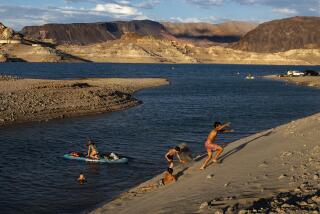Colorado Glacier Finds Put a Chill on Global Warming Trends
- Share via
ROCKY MOUNTAIN NATIONAL PARK, Colo. — Geologists exploring the rugged Continental Divide say they discovered more than 100 additional glaciers here in a single summer, a surprising find since glaciers around the world are shrinking in warmer temperatures.
The results dramatically change the map of one of the nation’s oldest and best-known national parks, along with the knowledge of weather and water cycles at high elevations.
Previously, officials believed the park 60 miles northwest of Denver included 20 permanent ice and snow features, including six named glaciers.
The new survey by geologist Jonathan Achuff shows there are as many as 120 such features. Most are in cold, north-facing pockets on the east side of the divide at elevations above 12,000 feet.
Most of the newly discovered glaciers are covered with rocky debris; continuous freezing and thawing splinters the brittle granite that forms some of the park’s majestic peaks. Park officials say comparisons with historical photos suggest that at least some of the glaciers are expanding.
Glaciers are barometers of climate change, and researchers said the survey results here contradict global warming trends.
In Antarctica, the Pine Island Glacier thinned by 36 feet in eight years; the rate of ice-thinning is 10 times greater than the rate of snowfall there.
In Africa, the famous white mantle of Mount Kilimanjaro has shrunk by 82% since 1912. A survey by Ohio State University researcher Lonnie G. Thompson predicts that the glacier, which straddles the equator, will vanish by 2015. Already, some rivers in Tanzania have dried up as a result, he said.
Similar icy retreats have been measured in the Andes of Peru and the Himalayas of Tibet. Aerial photos over the past three decades show the number of named glaciers in Montana’s Glacier National Park has dropped from 83 to fewer than 65.
Perhaps the only major glacial system that is increasing in size today is in Norway. Coastal glaciers are more complicated, and some global warming models predict increased snowfall there as precipitation patterns change.
In Colorado, park officials said subtle climate changes may be helping the formation of glaciers or at least reducing their retreat.
The divide already funnels snow from the West up and over ridges, where it settles in eastern basins just below the tallest peaks.
Also, expanding development near Denver is sending hot air that helps to form additional cloud cover over the mountains in the summer.
Although precipitation has not changed significantly, temperatures have been slightly cooler in the past several years.
“We’re not running quite in sync with global warming here,” park spokeswoman Judy Visty said.
Achuff and others are preparing expanded studies that would begin next summer, including the possibility of drilling core samples to the bottom of large ice features, using satellites to measure the glaciers’ movements and seismic testing to determine how much ice and rock the features contain.
Perhaps the most significant of the newly discovered glaciers is located beneath a boulder field near the 14,255-foot summit of Long’s Peak, one of the West’s most popular climbs. The glacier, it turns out, has been skirted by thousands of visitors annually.
Previously, some geologists speculated that the boulder field was a “rock glacier”--a catchall term for thick mixtures of debris and ice. But the granite may actually cover up a thick ice slab, insulating it from the sun.
“There could be a large chunk of ice under there, perhaps several hundred feet thick and a mile long,” Visty said.
More to Read
Sign up for Essential California
The most important California stories and recommendations in your inbox every morning.
You may occasionally receive promotional content from the Los Angeles Times.













